
Concept explainers
(a)
Interpretation: The product formed on thermal electrocyclic ring opening of the given compounds is to be predicted.
Concept introduction: Electrocyclic reactions involve ring opening or ring closure in a conjugated polyene. According to Woodward-Hoffmann rules, the polyene containing even number of bonds in thermal conditions undergoes reaction in conrotatory fashion and polyene containing odd number of bonds undergo reaction in disrotatory fashion.
Answer to Problem 25P
The product formed on thermal electrocyclic ring opening of the compound A is,
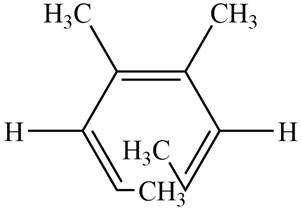
Figure 1
The product formed on thermal electrocyclic ring opening of the compound B is,

Figure 2
Explanation of Solution
The given compound A is,
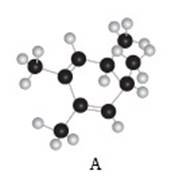
Figure 3
Black coloured atoms have four bonds. So, these are the carbon atoms. The grey coloured balls have one bond. So, these are the hydrogen atoms. The molecular structure is,
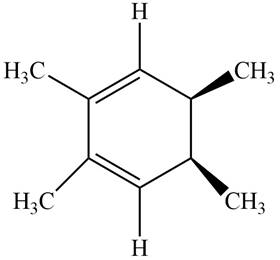
Figure 4
The given compound undergoes thermal electrocyclic ring opening to form product with three pi bonds. According to Woodward-Hoffmann rules, the ring opening takes place in disrotatory fashion. The atomic orbitals of the carbon atoms whose sigma bond is broken rotates in opposite direction. The corresponding

Figure 5
The given compound B is,
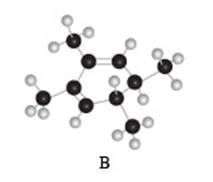
Figure 6
Black coloured atoms have four bonds. So, these are the carbon atoms. The grey coloured balls have one bond. So, these are the hydrogen atoms. The molecular structure is,

Figure 7
The given compound undergoes thermal electrocyclic ring opening to form product with three pi bonds. According to Woodward-Hoffmann rules, the ring opening takes place in disrotatory fashion. The atomic orbitals of the carbon atoms whose sigma bond is broken rotates in opposite direction. The corresponding chemical reaction is shown below.

Figure 8
The products formed on thermal electrocyclic ring opening of the compound A and compound B is are shown in Figure 1 and Figure 2.
(b)
Interpretation: The product formed on photochemical electrocyclic ring opening of the given compounds.
Concept introduction: Electrocyclic reactions involve ring opening or ring closure in a conjugated polyene. According to Woodward-Hoffmann rules, the polyene containing even number of bonds in photochemical conditions undergoes reaction in disrotatory fashion and polyene containing odd number of bonds undergo reaction in conrotatory fashion.
Answer to Problem 25P
The product formed on photochemical electrocyclic ring opening of the compound A is,
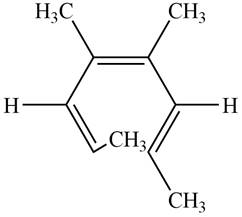
Figure 9
The product formed on photochemical electrocyclic ring opening of the compound B is,
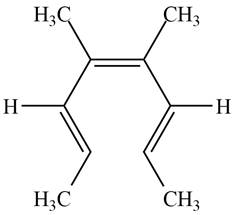
Figure 10
Explanation of Solution
The given compound A is,
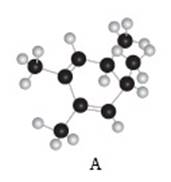
Figure 3
Black coloured atoms have four bonds. So, these are the carbon atoms. The grey coloured balls have one bond. So, these are the hydrogen atoms. The molecular structure is,
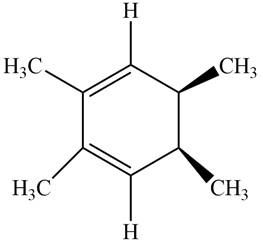
Figure 4
The given compound undergoes thermal electrocyclic ring opening to form product with three pi bonds. According to Woodward-Hoffmann rules, the ring opening takes place in disrotatory fashion. The atomic orbitals of the carbon atoms whose sigma bond is broken rotates in opposite direction. The corresponding chemical reaction is shown below.

Figure 11
The given compound B is,
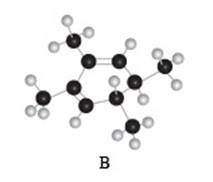
Figure 6
Black coloured atoms have four bonds. So, these are the carbon atoms. The grey coloured balls have one bond. So, these are the hydrogen atoms. The molecular structure is,

Figure 7
The given compound undergoes thermal electrocyclic ring opening to form product with three pi bonds. According to Woodward-Hoffmann rules, the ring opening takes place in disrotatory fashion. The atomic orbitals of the carbon atoms whose sigma bond is broken rotates in opposite direction. The corresponding chemical reaction is shown below.

Figure 12
The products formed on photochemical electrocyclic ring opening of the compound A and compound B is are shown in Figure 9 and Figure 10.
Want to see more full solutions like this?
Chapter 25 Solutions
Connect Online Access 1-Semester for Organic Chemistry
- (a) What product(s) are formed when the E isomer of C6H5CH = CHC6H5 is treated with Br2, followed by one equivalent of KOH? Label the resulting alkene(s) as E or Z. (b) What product(s) are formed when the Z isomer of C6H5CH = CHC6H5 is subjected to the same reaction sequence? (c) How are the compounds in parts (a) and (b) related to each other?arrow_forwardDraw all of the substitution and elimination products formed from thegiven alkyl halide with each reagent: (a) CH3OH; (b) KOH. Indicate thestereochemistry around the stereogenic centers present in the products,as well as the mechanism by which each product is formed.arrow_forwardFor alkenes A, B, C, and D: (a) Rank A—D in order of increasing heat ofhydrogenation; (b) rank A—D in order of increasing rate of reaction withH2, Pd-C; (c) draw the products formed when each alkene is treated withozone, followed by Zn, H2O.arrow_forward
- What product is formed when each compound undergoes thermal electrocyclic ring opening or ring closure? Label each process as conrotatory or disrotatory, and clearly indicate the stereochemistry around tetrahedral stereogenic centers and double bonds.arrow_forwardWhen (ft)-6-bromo-2,6-dimethylnonane is dissolved in CH3OH, nucleophilic substitution yields an optically inactive solution. When the isomeric halide (fl)-2-bromo-2,5- dimethylnonane is dissolved in CH3OH under the same conditions, nucleophilic substitution forms an optically active solution. Draw the products formed in each reaction, and explain why the difference in optical activity is observed.arrow_forward(a) Draw all products formed by treatment of each dibromide (A and B) with one equivalent of NaNH2. (b) Label pairs of diastereomers and constitutional isomers. H Br H Br CH3 CH3 Br H H Br Aarrow_forward
- Compounds A and B are both hydrogenated to methylcyclohexane. Which compound has the larger heat of hydrogenation? Which compound is more stable?arrow_forwardAcyclovir is an effective antiviral agent used to treat the herpes simplexvirus. (a) Draw the enol form of acyclovir, and explain why it is aromatic.(b) Why is acyclovir typically drawn in its keto form, despite the fact thatits enol is aromatic?arrow_forwardDehydration of 1,2,2-trimethylcyclohexanol with H2SO4 affords 1-tert-butylcyclopentene as a minor product. (a) Draw a stepwise mechanism that shows how this alkene is formed. (b) Draw other alkenes formed in this dehydration. At least one must contain a ve-membered ring.arrow_forward
- Dehydration of 1,2,2-trimethylcyclohexanol with H2SO4 affords 1-tert-butylcyclopentene as a minor product. (a) Draw a stepwise mechanism that shows how this alkene is formed. (b) Draw other alkenes formed in this dehydration. At least one must contain a five-membered ring.arrow_forwardIdentify the following pericyclic reaction; explain the course and stereochemistry of the reaction.arrow_forward| Anthracene readily undergoes a Diels-Alder reaction with tetracyanoethene, even though anthracene is NC CN ? + aromatic. NC CN (a) Draw two possible products that can form from this reaction. (b) Explain why anthracene can readily undergo a Diels-Alder reaction, whereas benzene does not.arrow_forward
 ChemistryChemistryISBN:9781305957404Author:Steven S. Zumdahl, Susan A. Zumdahl, Donald J. DeCostePublisher:Cengage Learning
ChemistryChemistryISBN:9781305957404Author:Steven S. Zumdahl, Susan A. Zumdahl, Donald J. DeCostePublisher:Cengage Learning ChemistryChemistryISBN:9781259911156Author:Raymond Chang Dr., Jason Overby ProfessorPublisher:McGraw-Hill Education
ChemistryChemistryISBN:9781259911156Author:Raymond Chang Dr., Jason Overby ProfessorPublisher:McGraw-Hill Education Principles of Instrumental AnalysisChemistryISBN:9781305577213Author:Douglas A. Skoog, F. James Holler, Stanley R. CrouchPublisher:Cengage Learning
Principles of Instrumental AnalysisChemistryISBN:9781305577213Author:Douglas A. Skoog, F. James Holler, Stanley R. CrouchPublisher:Cengage Learning Organic ChemistryChemistryISBN:9780078021558Author:Janice Gorzynski Smith Dr.Publisher:McGraw-Hill Education
Organic ChemistryChemistryISBN:9780078021558Author:Janice Gorzynski Smith Dr.Publisher:McGraw-Hill Education Chemistry: Principles and ReactionsChemistryISBN:9781305079373Author:William L. Masterton, Cecile N. HurleyPublisher:Cengage Learning
Chemistry: Principles and ReactionsChemistryISBN:9781305079373Author:William L. Masterton, Cecile N. HurleyPublisher:Cengage Learning Elementary Principles of Chemical Processes, Bind...ChemistryISBN:9781118431221Author:Richard M. Felder, Ronald W. Rousseau, Lisa G. BullardPublisher:WILEY
Elementary Principles of Chemical Processes, Bind...ChemistryISBN:9781118431221Author:Richard M. Felder, Ronald W. Rousseau, Lisa G. BullardPublisher:WILEY





